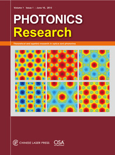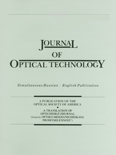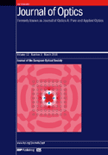
Ukrainian Journal of Physical Optics
metrics 2024
Leading the Charge in Optical Physics Scholarship
Introduction
The Ukrainian Journal of Physical Optics is a premier publication dedicated to advancing the field of optical physics, particularly strong in atomic and molecular physics. Founded in 2000 and published by INST PHYSICAL OPTICS, this journal has established itself as a leading platform for innovative research and scholarly discourse in optics, ranking in the top quartile (Q1) within its category according to the 2023 metrics. With an impressive Scopus rank of #30 out of 224 journals in the field, the journal garners significant attention, claiming an 86th percentile ranking that underscores its academic prestige. Researchers, professionals, and students alike will find a wealth of cutting-edge studies and insights within its pages, supported by open access options, which ensures global dissemination of knowledge. As the journal continues to converge into 2024, it remains a vital resource for those seeking to explore the depths of physical optics and contribute to the evolving landscape of this dynamic field.
Metrics 2024
 2.49
2.49 -
- -
- 21
21Metrics History
Rank 2024
Scopus
JCI (Web Of Science)
Quartile History
Similar Journals

Photonics Research
Pioneering Insights in Atomic and Molecular PhysicsPhotonics Research, published by Chinese Laser Press, is a premier international journal that aims to disseminate cutting-edge research and advancements in the field of photonics, encompassing areas such as atomic and molecular physics, optics, and materials science. Since its inception in 2013, this journal has established itself as a vital resource for academics and professionals, reflected in its impressive Q1 rankings in both Atomic and Molecular Physics, and Optics (15/224) and Electronic, Optical and Magnetic Materials (26/284) as per Scopus, underscoring its influence within the scientific community. With substantial contributions to the field, Photonics Research continues to foster innovation and collaboration among researchers, serving as an essential platform for the publication of high-quality studies that push the boundaries of knowledge. The journal operates on an open-access model, ensuring that research is readily available to a global audience, thereby enhancing its accessibility and impact. Whether you are a researcher, student, or professional, engaging with this journal offers a significant opportunity to stay at the forefront of photonic technologies and ideas.

PhotoniX
Empowering Research in Optics and EngineeringPhotoniX is a premier open-access journal published by SPRINGERNATURE in Germany, dedicated to the fields of Atomic and Molecular Physics, Optics, and Electrical and Electronic Engineering. Launched in 2020, this journal has swiftly established itself as a key resource within the scientific community, achieving impressive rankings, notably being placed in the Q1 quartile across its categories in 2023. With its Scopus ranks highlighting its excellence—2nd in Engineering (Miscellaneous), 9th in Electrical and Electronic Engineering, and 6th in Atomic and Molecular Physics—PhotoniX serves as a critical platform for researchers to disseminate their findings. With an emphasis on broadening access to cutting-edge research, the journal offers a valuable opportunity for engagement with contemporary advancements in the fields it covers. Researchers, professionals, and students can benefit significantly from its contents, contributing to the collective knowledge in these vital areas of science and technology.

Chinese Optics
Pioneering Discoveries in the Realm of Optical Sciences.Chinese Optics is a premier journal dedicated to advancing the field of optics, encompassing research on atomic and molecular physics. Published by the esteemed Changchun Institute of Optics Fine Mechanics & Physics in China, this journal supports the sharing of cutting-edge findings since its inception in 2010. With an ISSN of 2097-1842, it operates within a competitive landscape, currently positioned in Q3 of the category for Atomic and Molecular Physics and Optics, according to the 2023 metrics. While the journal is not open access, it offers a valuable platform for researchers, professionals, and students to explore and contribute to significant discoveries in the realm of optics and light technology. By fostering scholarly communication, Chinese Optics plays a crucial role in bridging theoretical and practical aspects, making it an indispensable resource for those passionate about the optical sciences.

OSA Continuum
Bridging Theory and Application in Optical SciencesOSA Continuum, published by the Optica Publishing Group, is a distinguished open access journal dedicated to advancing research in the realms of Atomic and Molecular Physics, Optics, and Electronic and Electrical Engineering. Since its inception in 2018, this journal has rapidly positioned itself as a significant platform for disseminating cutting-edge findings, achieving impressive Scopus rankings with a 61st percentile in Electrical and Electronic Engineering and 57th in Atomic and Molecular Physics. Based in the United States, the journal not only promotes scholarly dialogue among researchers and professionals but also plays a crucial role in bridging theoretical advances with practical applications in optical and material sciences. Its open access format ensures broader visibility and accessibility of research outputs, fostering innovation and collaboration across disciplines. With its ongoing commitment to excellence, OSA Continuum is crucial for anyone involved in these dynamic fields.

OPTICAL AND QUANTUM ELECTRONICS
Driving Breakthroughs in Quantum TechnologiesOPTICAL AND QUANTUM ELECTRONICS, published by SPRINGER, is a premier journal dedicated to advancing the fields of atomic and molecular physics, optics, and electronic engineering. With an ISSN of 0306-8919 and an E-ISSN of 1572-817X, this journal has established itself as a vital resource for researchers, professionals, and students alike, contributing to the discourse from its inception in 1969 to its continued publications through 2024. It holds impressive rankings in Scopus, placing within the top percentiles for its categories, specifically in the 64th for Electrical and Electronic Engineering and 63rd for Atomic and Molecular Physics. Though it does not currently offer open access options, the journal's robust impact factor reflects its importance within its field, making it an essential reference point for cutting-edge research and developments in materials science and optics. Through its rigorous peer-review process, OPTICAL AND QUANTUM ELECTRONICS remains committed to publishing high-quality, influential studies that push the boundaries of innovation and understanding in these dynamic areas of science.

Advanced Photonics
Exploring the Boundaries of Light and InnovationAdvanced Photonics, published by SPIE-SOC PHOTO-OPTICAL INSTRUMENTATION ENGINEERS, is a prestigious open-access journal dedicated to cutting-edge research in the fields of photonics, optics, biomedical engineering, and material science. Since its inception in 2019, this journal has successfully established itself in the top quartile (Q1) of various categories, including Atomic and Molecular Physics, Biomedical Engineering, and Electronic, Optical and Magnetic Materials, showcasing its critical role in advancing knowledge and innovation within these disciplines. With impressive Scopus rankings—#8 in Biomedical Engineering, #7 in Atomic and Molecular Physics, and #10 in Materials Science—Advanced Photonics serves as an essential platform for researchers, professionals, and students alike, offering a wealth of accessible scholarly content to keep pace with rapid technological developments. The journal not only fosters collaboration and knowledge dissemination within the global scientific community but also emphasizes the importance of open access to ensure that groundbreaking research benefits society as a whole.

JOURNAL OF OPTICAL TECHNOLOGY
Driving Progress in Optical DisciplinesJOURNAL OF OPTICAL TECHNOLOGY, published by the Optica Publishing Group, serves as a vital resource for researchers and professionals in the fields of optical technology and related disciplines. Established with a commitment to advancing knowledge, this journal spans a broad spectrum of topics, including applied mathematics, atomic and molecular physics, and various engineering disciplines, with a converged publication period from 1995 to 2024. Although it currently holds a Q4 ranking across multiple categories in 2023, it is an important platform for innovative research ideas in a rapidly evolving field. The absence of Open Access may guide readers to explore alternative access options through institutional subscriptions. The journal’s ISSN is 1070-9762 and its E-ISSN is 1091-0786, ensuring accessibility for a global audience. As a publication aimed at fostering scholarly communication, it invites contributions that highlight emerging trends and novel developments in optical technology, catering to a multifaceted audience of researchers, professionals, and students.

Journal of Optics
Exploring the Frontiers of Optical ScienceThe Journal of Optics, published by IOP Publishing Ltd, stands as a pivotal platform for disseminating cutting-edge research in the fields of atomic, molecular physics, and optics as well as electronic, optical, and magnetic materials. With an impact factor reflective of its esteemed position—ranking in the 60th percentile in both relevant Scopus categories—this journal, boasting an ISSN of 2040-8978 and an E-ISSN of 2040-8986, is uniquely positioned to foster innovation and collaboration among researchers, professionals, and students worldwide. Located in the United Kingdom and operational since 2010, the journal embraces an open access model, promoting maximal reach and engagement with the latest discoveries that shape the future of optics. As it continues to evolve through its converged years up to 2024, the Journal of Optics remains a critical resource for those seeking to advance their knowledge and influence in this dynamic field.

ACTA OPTICA SINICA
Advancing Discoveries in Light and MaterialsACTA OPTICA SINICA is a distinguished journal dedicated to the field of optics and photonics, published by the Chinese Laser Press. With an ISSN of 0253-2239, this journal has been an essential resource since its inception, covering significant discoveries and advancements in atomic and molecular physics, electronic materials, and optical sciences. The journal is indexed in Scopus, achieving respectable ranks as Q3 in both Atomic and Molecular Physics, and Optics and Electronic, Optical and Magnetic Materials, reflecting its engagement with current research trends. Although it is not an open-access journal, ACTA OPTICA SINICA is hosted from Shanghai, China, and continues to serve as a vital platform for researchers, professionals, and students alike to disseminate and access high-quality peer-reviewed articles, ensuring its prominent place in the academic discourse related to optics and material sciences.

Chinese Optics Letters
Fostering innovation in atomic and molecular physics.Chinese Optics Letters is a prestigious academic journal published by Chinese Laser Press, dedicated to advancing the fields of atomic and molecular physics, optics, as well as electrical and electronic engineering. Since its inception in 2003, this journal has become a significant platform for researchers and professionals to disseminate innovative findings and foster collaboration within these rapidly evolving disciplines. With a commendable Q2 ranking in leading categories including Atomic and Molecular Physics and Electronic, Optical and Magnetic Materials, it ranks favorably within the Scopus database, with notable positions in both engineering and materials science sectors. The journal is headquartered in Shanghai, China, and while additional open access options are not specified, it remains a vital resource for those committed to pushing the frontiers of optical research and applications. As we approach 2024, Chinese Optics Letters continues to play an essential role in shaping scholarly discourse and technological advancement in optics.